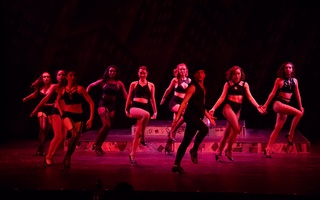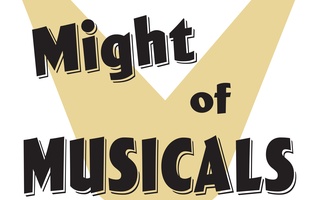{shortcode-fc0a6d7c6c491eb61742632ec0102e830a0e207b}The Harvard College Musical theater brought all that jazz to Harvard with its production of the beloved Broadway musical, “Chicago.” Through its spot-on casting, talented orchestra players, and professional choreography, HCMT made it clear that “Chicago” deserves its place in the hearts of musical theater aficionados.
The jazz-fueled musical follows Roxie Hart (Annabel O’Hagan ’19), a lovable aspiring star who finally gets the chance to take the spotlight through somewhat unconventional means — the murder of her illicit lover. With the help of her pitifully devoted husband Amos (Ethan Craigo ’19), a smooth-talking lawyer Billy Flynn (Kyler Chase ’19), a conniving prison warden “Mama” Morton (Genevieve Lefevre ’20), and her frenemy Velma Kelly (Ashley M. LaLonde ’20), Roxie discovers a variety of tactics to make the trial go her way. This means more than just getting a “not guilty” verdict, as Roxie’s biggest focus is simply getting attention. The enthralling plot and catchy tunes have made “Chicago” an extremely popular show, leading to multiple revivals and even a 2002 Academy Award-winning film of the same name.
HCMT’s take on Broadway’s longest running American musical does not diverge too greatly from typical productions. The set is minimal, the costumes are practically underwear, and the spotlights are practically main characters. However, there are a few key differences that affect the overall tone of the show. The show completely changes the character Mary Sunshine and her subplot. In most versions of the show, Sunshine is played by a man with a very impressive falsetto range, which is showcased when Flynn removes her wig during the trial. This scene is usually played for laughs, but could only add a layer of transphobia to an otherwise delightful show. As such, director Ryan T. Kapur ’20 decided to remove these aspects of the character, instead framing her as an ordinary reporter played by Allison Toledo ’19. Kapur certainly made the right call, but it begs the question of whether the character even needs to be included.
Another major change was the location of the pit. “Chicago” is unique in that it often features a visible jazz band, which helps invoke the atmosphere of a 1920s jazz club. By putting the musicians front and center, and featuring numerous vocalless overtures, viewers are treated to two shows in one — a plot-driven musical and a stunning jazz performance. HCMT, however, placed the band in its usual, invisible location below the stage. This detracted from what is one of the most enjoyable experiences of seeing this musical in particular, and it relegated the hard working musicians to the sidelines. Considering the great talent of HRDC’s pit, this was a disappointing move.
Thankfully, the production excelled in every other department. First and foremost, O’Hagan stole the show. It is delightful to see a Roxie that can sing so beautifully while also effectively showcasing the character’s fiery personality. Perhaps just as delightful is the casting of Velma. LaLonde’s Velma perfectly complements O’Hagan’s Roxie. In fact, though some casting choices seemed unusual at first — Lefevre’s Mama was certainly not a belter, and Craigo’s Amos is far from plain — every single performer justified their place on stage with fantastic singing and equally engaging acting.
Of course, “Chicago” is about a lot more than just singing and acting. True to its focus on 1920s Vaudeville stars, dancing plays an especially important role in the musical. The choreography for this production, uniquely created by Kapur himself, was at a professional level. A variety of 1920s dance styles were represented, from the memorable chair dance in “Cell Block Tango” to Amos’ adorably simple jazz hands in “Mr. Cellophane.” While certainly honoring Bob Fosse’s legacy, Kapur’s choreography stood out in its own right, certainly helped by the performers’ adeptness in enacting it.
“Chicago” is a particularly difficult musical to put on successfully, as the numerous Broadway productions and the movie set expectations particularly high. Though not without flaw, HCMT’s productions met these expectations and more, providing a much needed break from reality through the delights of jazz, liquor, and semi-justified murder. One can only imagine the great skill required to act, sing, and dance in front of a huge crowd, all while wearing lingerie.
Correction: Nov. 2, 2018
A previous version of this article incorrectly indicated that the Harvard Radcliffe Dramatic Club produced this verison of "Chicago." In fact, Harvard College Musical Theater produced it.
Read more in Arts
Guadagnino’s ‘Suspiria’ Digs Far Deeper Than the OriginalRecommended Articles
-
MORE PUDDING, PLEASETo the Editors of the CRIMSON: The Hasty Pudding engaged me to produce their show, Strike While It's Hot. As
-
 A Refreshing Lack of Romance
A Refreshing Lack of Romance -
Lack of Female Agency in the “Mean Girls” MusicalCady’s agency is stripped away as her epiphany shifts from an internal realization to the acceptance of external advice. This change endorses the idea that women should allow outside opinions to dictate their actions, problematic in any context but even more so in a story where self-determination is a driving theme.
-
 ‘Chicago’ Arrives at Harvard with Tradition and Twists
‘Chicago’ Arrives at Harvard with Tradition and Twists -
 Oversimplified Bigotry in ‘Kinky Boots’ Musical
Oversimplified Bigotry in ‘Kinky Boots’ Musical













